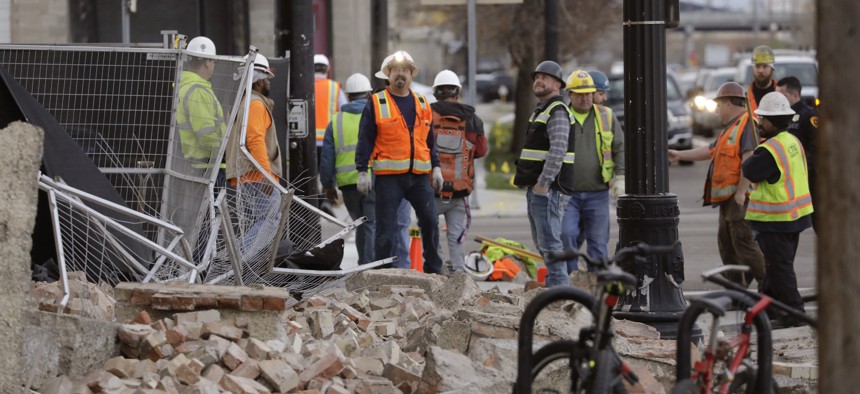Disasters Collide: How the Pandemic Will Affect Response to Natural Disasters

Natural disasters, like the recent 5.7 magnitude earthquake in Salt Lake City, will further strain state and local resources already consumed by the coronavirus pandemic. AP PHOTO/RICK BOWMER
COMMENTARY | Flooding and tornado season are underway and hurricane season is just around the corner. How will state and local governments—already strained by the coronavirus pandemic—deal with other natural disasters?
Some reports indicate that the spread of the coronavirus will continue through this summer, meaning we will need social distancing measures in place in some form for several months. But, the pandemic won’t stop other natural disasters from occurring, as the recent earthquake in Salt Lake City reminds us. Spring flooding, tornadoes and the first part of hurricane season will all occur before the number of Covid-19 cases dissipate. We need to start preparing now and begin to think through some of the major challenges that will arise when responding to multiple disasters simultaneously.
Displacements
As states have aggressively implemented extreme, but necessary, social distancing measures, evacuations and displacements will be one of the most significant challenges for future weather events. For impending hurricanes, we normally ask people to evacuate from the coast and storm surge areas. When people are forced out of their homes because of tornadoes or fires, we ask them to go to friends and relatives, to hotels, or temporary shelters in schools, community centers and churches. None of those are good options now. We would simply be moving individuals from one peril to another. What are we going to tell people where to go if they need to leave their home?
Commodities
The fundamental change in the way retailers are operating now will become acutely apparent in the run-up to and recovery from a disaster. Limited store hours and staff availability will make it harder for families to get the recommended 72-hour emergency food, water and supplies kit. And the warehouses that federal, state and territorial governments normally maintain with food, water and tarps may instead be stocked with masks, sanitizer and testing kits. In the absence of routine supplies, additional hardship could occur.
Hospitals
Getting hospitals ready for the impacts of natural disasters has always been challenging. Hospital leaders are faced with the difficult tasks of determining if and when they should move their patients, readying health care facilities for the potential influx of survivors and ensuring enough staff are on hand to deal with the situation. Over the next few months those hospitals will be overwhelmed with coronavirus patients, and there will be no excess capacity to move patients if they have to evacuate. Similarly, any temporary facilities built to handle patient overflow and triage will be no match for the winds of a hurricane or a tornado and would need to be abandoned as well. Where will patients and healthcare workers go? And how will we continue to care for them and any new patients impacted by the disaster?
Economic implications
Finally, the economic strain caused by the pandemic will affect those who were already the most vulnerable to natural disasters. Forty percent of Americans already don’t have $400 ready to use in emergencies. Now, many more Americans will find themselves underemployed or unemployed. These individuals will struggle mightily to afford to pay for a hotel to shelter in or to buy emergency supplies to take care of themselves in the event of a prolonged power or water outage. Additionally, we may see people start to drop their flood insurance or home insurance, and become even more reliant on the support of government and charitable organizations at a time when those institutions are already strained. This will slow recovery, adding another layer of economic burden on communities already teetering on the brink.
The bottom line here is that leaders of every government agency, private business, charitable organization and family need to start thinking about how they’re going to deal with the inevitable natural disasters yet to come.
Government simply has no choice but to respond to the emergency of today while planning for the potential disasters of the next few months. A national intensive, collaborative and comprehensive planning effort, led by the federal government, is necessary to address these issues. State and local personnel, already strained by the pandemic, will not have the bandwidth, and the results would be potentially uneven and uncoordinated. The coronavirus pandemic has shown us that delaying action or pretending it can’t happen isn’t the right approach—the time to start planning for these events is now.
OTHER STORIES from Route Fifty:
Bryan Koon is the Vice President of Homeland Security and Emergency Management at IEM, and served as the Director of Florida’s Division of Emergency Management from February 2011 until October 2017 and the Director of Emergency Management at Walmart from 2009 until 2011.
NEXT STORY: New Jersey Set to Release 1,000 Jail Inmates to Limit Coronavirus Spread





